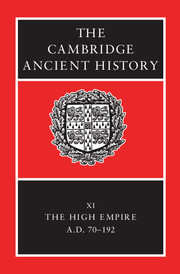Book contents
- Frontmatter
- PART I NARRATIVE
- PART II GOVERNMENT AND CIVIL ADMINISTRATION
- PART III THE EMPIRE
- PART IV ROME, ITALY AND THE PROVINCES
- 12 Rome and Italy
- 13 Spain
- 14 Gaul
- 15 Roman Germany
- 16 Africa
- 17 Cyrenaica
- 18 Britain
- 19 The Danube provinces
- 20 Greece and Asia Minor
- 21 Syria and Arabia
- 22 Judaea
- PART Va ECONOMY AND SOCIETY
- PART Vb ART AND CULTURE
- Chronological Table
- BIBLIOGRAPHY
- Index
- 1 The Roman world in the time of Marcus Aurelius
- 7 The Danube provinces
- References
16 - Africa
from PART IV - ROME, ITALY AND THE PROVINCES
Published online by Cambridge University Press: 28 March 2008
- Frontmatter
- PART I NARRATIVE
- PART II GOVERNMENT AND CIVIL ADMINISTRATION
- PART III THE EMPIRE
- PART IV ROME, ITALY AND THE PROVINCES
- 12 Rome and Italy
- 13 Spain
- 14 Gaul
- 15 Roman Germany
- 16 Africa
- 17 Cyrenaica
- 18 Britain
- 19 The Danube provinces
- 20 Greece and Asia Minor
- 21 Syria and Arabia
- 22 Judaea
- PART Va ECONOMY AND SOCIETY
- PART Vb ART AND CULTURE
- Chronological Table
- BIBLIOGRAPHY
- Index
- 1 The Roman world in the time of Marcus Aurelius
- 7 The Danube provinces
- References
Summary
THE EMPERORS AND AFRICA
After his victory in the civil wars, the emperor Vespasian put it about that he was a man of blunt words and business-like determination. His job was to restore the empire under the slogan, ‘Get it stable first and then embellish it.’ And at the core of the programme was a regime of tight fiscal and economic discipline.
Africa needed stability. There was insecurity in the southern border lands caused by semi-nomadic incursions; vast new imperial estates had been created by Nero, which had then been increased through confiscations after the civil war; the tax system was confused by confiscations and immunities which had been granted by rival emperors; and the vital corn supply had been threatened by imperial pretenders. It is easy, of course, to exaggerate the novelty of the programme, as Vespasian's propaganda intended, and to overstate the achievement. But there is little doubt that Vespasian took some important steps towards the romanization and rationalization of Africa in the years after the civil war, which set the agenda for the second century. We must not forget that Vespasian's wife came from Sabratha in Tripolitania and that he himself, as governor around a.d. 63–66, was the first emperor ever to have set foot in Africa. That may explain why his rule appears more interventionist than that of most of his successors. Although neither Trajan nor Hadrian spent much time in Rome, Trajan never visited Africa at all and Hadrian, despite a reign of almost constant travelling, only made one certain visit in a.d. 128, when he addressed the army at Lambaesis.
- Type
- Chapter
- Information
- The Cambridge Ancient History , pp. 514 - 546Publisher: Cambridge University PressPrint publication year: 2000
References
- 3
- Cited by



